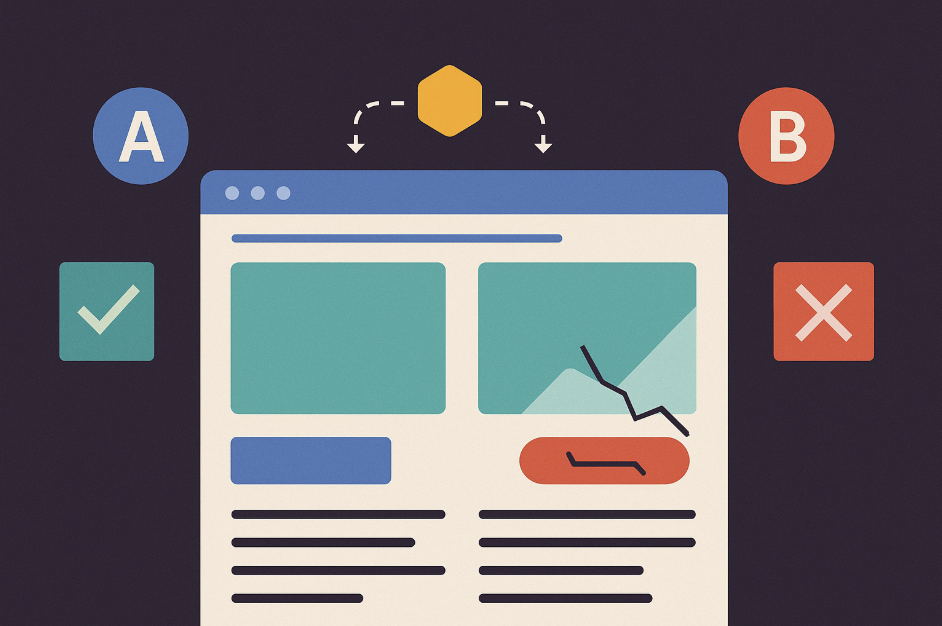
Yusuf Shurbaji
July 3, 2023
|
6.5
min read
As a small business owner, it’s vital to understand how your target audience members interact with your brand website. While you can use generalized heatmaps, click maps might often be better to improve your conversion rate and how you design user experiences going forward.
So what exactly are click maps, how do they work, and how can they benefit your business? Let’s get into it.

Put simply, a click map is a specialized type of website heatmap. In a nutshell, a click map displays exactly where a site user or visitor clicks their mouse cursor on a desktop device. If the visitor is on mobile, it shows you where they tap the screen with a finger or stylus.
For example, you might look at a click map of the web traffic to your landing page. On the landing page, you’ll see a host of different colors. Like standard heatmaps, click maps display areas with more clicks and traffic as “hot” colors like red to yellow.
Areas with fewer clicks and less traffic don’t have any extra color or appear in cool shades like green, blue, and purple.
On a standard landing page, you might see a lot of traffic:
You’ll be less likely to see a lot of traffic in empty space throughout the page and generally further down the page (this holds true no matter which page you look at).
Regardless, click maps explicitly tell you where users click, not what they look at. The two are usually the same, but keep that in mind when analyzing your click map results.

As you can see from the above description, a click map is essentially a heatmap — it just focuses on clicks instead of cursor movement, scrolling, or other features.
Many high-quality tools that allow you to create and analyze heatmaps also allow you to automatically filter for clicks, thus creating click maps out of available heatmap data.
Regardless, click maps are more specialized. This can be advantageous in a variety of situations.
There are many different types of clicks and user actions you contract with a given click map.
Here are just a few examples:
Given all these different click types, it’s a no-brainer to collect click data as often as possible. Depending on the heatmap tool you use, it may enable you to track all of these clicks or just a handful of different click types. Know which clicks you want to track before settling on any heatmap or audience-tracking software.
Indeed, you can use click maps for many reasons and experience key benefits for your brand. Let’s take a closer look.
First and foremost, click maps enable you to determine – of course – where your site visitors click most frequently on your pages. That’s valuable information for a number of reasons.
For example, if you want to know whether a specific page link is working or is visible to your target audience members, a click map can tell you that. On the reverse side, a good click map will tell you if certain buttons need to be improved, repositioned, or otherwise changed to make them easier or more interesting to click.
Click maps also enable you to optimize your CTAs or calls to action. A call to action is usually a button or link leading to a contact or order page, asking a prospect or customer to make a purchase, subscribe to a newsletter, or take some other positive action.
With a click map, you can see which CTAs and CTA buttons are most effective and which ones are left by the wayside. In this way, you can improve your CTA conversion rate.
For instance, you might notice that one CTA button isn’t clicked on frequently, so you move it toward the top of the page. After that, it gets much more traffic, according to future click maps.
Click maps further enable you to identify different bugs or dead links on a given web page. For example, if you see a bunch of rage clicks (one of the click types mentioned above) on a link on your page, then visit for yourself, you might see that the link doesn’t work, and visitors are frustratedly clicking on it to get it to function.
With this information, you can fix dead links on those pages and improve user experiences. Similarly, click maps allow you to find a variety of different bugs by paying attention to what people do and do not click on.
In a broad sense, click maps are valuable and can be used to improve UX and conversion rates by giving you a visual representation of engagement data. In many cases, it can be tough to imagine and realize what your audience members are engaging with on a given web page.
With a click map, you can immediately see:
This information can tell you a lot about what people think about your website or a specific page, enabling you to make targeted, effective changes.
In the long run, click maps give you the tools you need to make changes for overall UX improvement.
For instance, if you notice audience members clicking much less frequently at the bottom half of your web page, you can improve the UX by moving valuable content further down, making the page load more quickly, and so on.
UX improvement takes a lot of small steps in most cases. Click maps can help you identify those steps for maximum impact.
In summary, click maps are specialized heatmaps that allow you to see exactly where your site visitors click and how frequently they do so. With the right click map analysis, you’ll have a much better understanding of how your target audience members use your website, where they go, and how best to improve your site’s layout and user interface for maximum engagement.
Of course, revamping your website by yourself is easier said than done. But you don’t have to tackle this project alone. Prismfly’s conversion rate optimization experts are well-equipped and ready to help you implement, measure, and understand click maps from start to finish.
Armed with that information, they’ll help you improve your UI and UX for each of your target visitors. Contact us today to get started.

Yusuf Shurbaji
Co-Founder & Managing Partner
Yusuf Shurbaji has over a decade of ecommerce growth experience. His past work includes building optimization departments & running experimentation inhouse and agency side for Dior, JCPenney, LVMH, American Precious Metals Exchange, Princess Polly, Built Brands, Ladder Sport, Maze Group, HelloFresh, Ledger, Blockchain.com, Kind Snacks, and other 9-figure brands. Yusuf is a Co-Founder of Prismfly, a conversion rate optimization agency focused on growing revenue and EBITDA for D2C ecommerce brands. Prismfly is the first CRO focused Shopify Plus certified agency and has seen triple digit growth the past 2 years.
Yusuf Shurbaji





